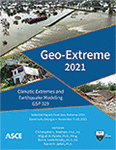Systems Thinking and Decision Making versus Location-Specific Approaches in Co-Seismic Slide Masses—Examples for Designers from the Farmington Siding Complex
Publication: Geo-Extreme 2021
ABSTRACT
The Farmington Siding Landslide Complex is a mapped paleo coseismic landslide in Davis County, Utah, that extends several kilometers beneath heavily developed urban and suburban areas. In design and development of new infrastructure on the complex, there are implications for systems thinking decision approaches for analyzing and mitigating the extreme event hazards versus location or project-specific approaches. Typical landslides or lateral spreads are commonly limited to areas that are a few tens to hundred meters across and systems approaches are not warranted due to the small spatial extents. When dealing with landslides that are several kilometers in width, the implications of compounding effects and unintended consequences of design decisions become pronounced. For example, if a new highway bridge is constructed in the area, how will potential ground improvements to protect individual bridges be designed to resist such large spatial impacts? How will the new highway affect the impacts to pre-existing infrastructure? Are the costs to keep a bridge standing warranted when there will be no undamaged or usable roads to access the bridge? Concepts of performance-based design and resilience enter into these decision-making processes. We use the Farmington Siding Landslide Complex as a canvas on which to discuss these different approaches and the impacts of different decisions both on single site projects and the system as whole.
Get full access to this article
View all available purchase options and get full access to this chapter.
REFERENCES
Amini, Z. (2008). Experimental and numerical study on the mechanisms of liquefaction flow-slides in gently sloping ground. MS Thesis. University of Utah.
Bray, J. D., and Travasarou, T. (2007). Simplified procedure for estimating earthquake-induced deviatoric slope displacements. Jrnl of Geotech. and Geoenviron. Eng, 133(2), 381–392.
Cattano, C., et al. (2011). “Teaching Systems Thinking and Biomimicry to Civil Engineering Students.” Jrnl of Professional Issues in Eng Education and Practice, 137(4): 176–182.
Franke, K. W., and Bartlett, S. F. (2019). Probabilistic Liquefaction Triggering and Lateral Spread Hazard Maps for Davis, Weber, and Salt Lake Counties, Utah: Collaborative Research with University of Utah and Brigham Young University.
Gillins, D. T., and Bartlett, S. F. (2014). “Multilinear Regression Equations for Predicting Lateral Spread Displacement from Soil Type and Cone Penetration Test Data.” Jrnl of Geotech. and Geoenviron. Eng, 143(5).
Lowe, M., and Harty, K. M. (1993). Geomorphology and failure history of the earthquake-induced Farmington Siding landslide complex, Davis County, Utah. Annual meeting of the Cordilleran Section and the 46th annual meeting of the Rocky Mountain Section of the Geological Society of America (GSA), Reno, NV (United States), 19-21 May 1993.
Lowe, M., Kirby, S. N., and Harty, K. M. (2018). Geologic map of the Farmington Quadrangle, Salt Lake and Davis Counties, Utah. Utah Geologic Survey, Salt Lake City, Utah.
Meadows, D. H. (2008). Thinking in Systems: A Primer. Earthscan, London, UK.
Miller, R. D., Olsen, H. W., Erickson, G. S., Miller, C. H., and Odum, J. K. (1981). Basic data report of selected samples collected from siz test holes at five sites in the Great Salt Lake and Utah Lake valleys.
Rathje, E. M., and Saygili, G. (2009). Probabilistic assessment of earthquake-induced sliding displacements of natural slopes. Bult. of the New Zealand Society of EQ Eng, 42(1), 18–27.
Youd, T. L., Hansen, C. M., and Bartlett, S. F. (2002). “Revised multilinear regression equations for prediction of lateral spread displacement.” Jrnl of Geotech. and Geoenviron. Eng, 128(12), 1007–1017.
Zhang, G., Robertson, P. K, and Brachman, R. W. (2004). “Estimating liquefaction-induced lateral displacements using the standard penetration test or cone penetration test.” Jrnl of Geotech. and Geoenviron. Eng, 130(8), 861–871.
Information & Authors
Information
Published In
Copyright
© 2021 American Society of Civil Engineers.
History
Published online: Nov 4, 2021
Authors
Metrics & Citations
Metrics
Citations
Download citation
If you have the appropriate software installed, you can download article citation data to the citation manager of your choice. Simply select your manager software from the list below and click Download.
